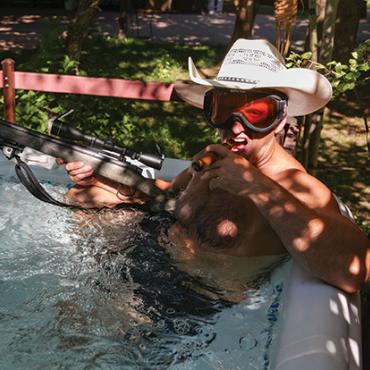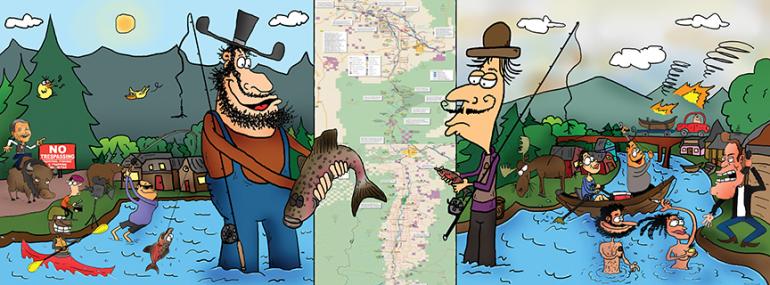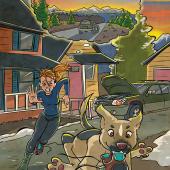Face-Off: Gallatin Vs. Bitterroot
The war of the waters.
From the roaring whitewater of spring to lazy, late-summer floats, rivers help narrate the story of Montana. They define our landscape, irrigate our crops, and protect our wildlife; they’re a primary source of recreation and identity; they help sustain our economy. But not all rivers are created equal. Our home waterway, the clear and stately Gallatin, calls to mind Shakespeare’s description of a certain African queen: “Age cannot wither her, nor custom stale her infinite variety.” But can our Cleopatra compete with Missoula’s own noble matron, the beautiful Bitterroot? Let’s find out.
Name Recognition
The Lewis and Clark–era statesman for whom the Gallatin is named has long been forgotten—maybe because 1892 was the last time anyone named their kid Albert. Not to mention the invariable doofus who pronounces it Guh-LATT-in. The Bitterroot, conversely, is our state flower and a word that rolls sweetly off the tongue—which may be why the Indigo Girls wrote a song about it. Nothing even rhymes with Gallatin.
Edge: Bitterroot
Access
With much of the river inside the national-forest boundary, the upper Gallatin offers dozens of impromptu pull-outs on top of the standard assortment of official access sites and campgrounds. Development surrounds the Bitterroot, but with all that sprawling suburbia comes bridges—which means quick and easy access.
Edge: Bitterroot
Scenery
Both rivers originate in pristine alpine country, tumble down rugged canyons, and meander through fertile valleys framed by mountain peaks. The Bitterroot’s beauty is often extolled by Missoula-based poets and novelists—but if it’s so darn special, why did Redford bring his crew here to film A River Runs Through It?
Edge: Gallatin
Wildlife
Both rivers enjoy abundant bird life and all the usual Montana mammals: moose, deer, porcupines, black bears, beavers, mink, et al. The Bitterroot Valley can claim the incredible Lee Metcalf National Wildlife Refuge, but the upper Gallatin is in Yellowstone Park, home of big, shaggy bison—and half-ton megafauna tend to tip the scales.
Edge: Gallatin
Lewis & Clark Adventures
Captain Clark’s journey to the Yellowstone, guided by Sacajawea, established several important sites along the Gallatin. But he hauled 50 horses and 20 men all the way to the headwaters of the Bitterroot. Throw in the expedition’s famous—and near-perilous—ascent of Lolo Pass, and this one’s not even close.
Edge: Bitterroot
Boating
For casual floating, it’s no contest: unlike the slower, safer Bitterroot, the lower Gallatin’s a minefield of sweepers, strainers, and other hazards; beer-swilling inner-tubers are thus limited to the short stretch below Manhattan. But when it comes to whitewater, the sedentary Bitterroot can’t compete. We’ve got House Rock, the Mad Mile, and other adrenaline-inducing features; on a good day, the Bitterroot might hit Class II.
Edge: Tie
Territorial Celebrities
In Gallatin Canyon, media mogul Ted Turner’s got a small country cordoned off with “No Trespassing” signs; only a cool 15 grand and an elk tag gets you through the gate. In the Bitterroot, ‘80s rocker Huey Lewis got his panties in a bunch over the local riff-raff fishing “his” creek. Both protect their property like hornets and follow the mantra of “sue first, talk later.” Aging businessman or washed-up pop star? Too close to call.
Edge: Tie
Trophy-Home Infestation
Floaters on both streams suffer ongoing exposure to flashy riverside “cabins”—complete with two-story picture windows, backyard teepees, and lacquered wooden arches. While these eyesores are sprouting up everywhere, the Bitterroot Valley’s endemic private-property-rights fanaticism translates into ten times the damage. Besides, the Gallatin’s got three nonprofits dedicated to protecting it; the Bitterroot has... none? Maybe they’re all too busy saving up for their own Montana McMansions.
Edge: Gallatin
Most Likely Cause of Death
Every year, some poor soul drowns on the Gallatin—often a rotund tourist who flops out of his raft and can’t make the 20-yard swim to shore. But how many people have burned alive in the Bitterroot’s frequent forest fires? Inhaling river water while pinballing off rocks, or lung-scorching smoke and the smell of your own burning flesh—asphyxiation sucks either way.
Edge: Tie
Culmination
The Bitterroot eventually empties into the Clark Fork; the much longer Gallatin is part of the titanic triumvirate that forms the Missouri River. Banal and uneventful assimilation, or birthing the Mighty Mo? Enough said.
Edge: Gallatin
Score: 4 to 3
Winner: Gallatin
Well, Bitterroot, who’s the prettiest flower now? You’re a good queen and our beloved sister to the west; but the Gallatin’s still the best.














